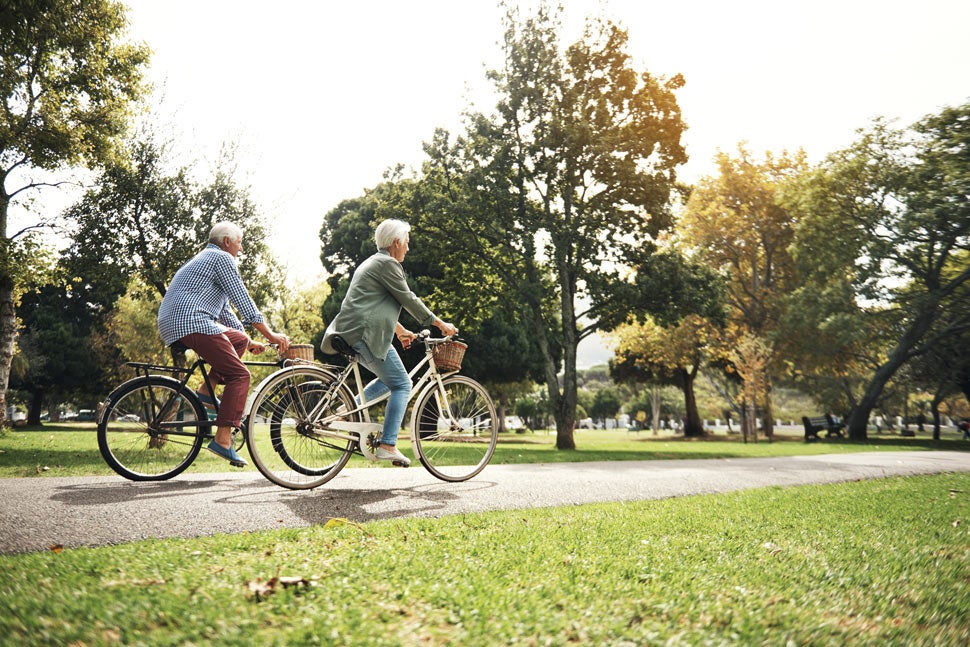Fitness
Biking Your Way to Better Health

Riding a bicycle can be an excellent fitness activity.
Cycling is also a good way to cross-train, because it puts much less stress on your joints, knees, and hips than running or walking. Getting a good workout on a bike isn't always easy, though, because you have more time to recover — or to just coast.
With this in mind, here's how to get the most out of your ride, whether you're cycling on vacation, around your neighborhood, or to and from work.
Size up your bike
Your bike should be sized according to your body proportions, according to the International Bicycle Fund (IBF). Since you can't change a bike's frame size, go to a bike dealer who can fit you correctly. To choose a bike with the correct frame size, you would put a leg on either side of the top tube, stand with both feet flat on the ground, and check the room between the top tube and your crotch. The recommended amount of room depends on the type of riding you will be doing — 1 inch to 2 inches for road riding and double that for off-road riding. Sizing may vary by brand. It may be different from bicycle to bicycle.
Seat height also is important. To make sure your seat is at the right level, sit comfortably on the saddle and fully extend your right leg with your right heel resting on the pedal in the 6 o'clock position. Sit squarely on the seat with your hands on the handlebars.
If your seat is at the correct height, you'll have a slight bend at the knee (the knee should be bent at an angle of 25° to 30°). For the most comfort, the seat should be level or tilted slightly downward.
Use your gears
Most all-terrain bikes have 15 to 21 gears. To get a good workout, learn to use all of them, the IBF says. In general, gear down when you're riding into the wind or uphill. Gear up when riding with the wind or downhill. The gears should be used to keep a steady pace whether going uphill or down, into the wind, or with the wind at your back.
Ideally, you should always ride in a gear that allows you to maintain your target heart rate — 50% to 70% of your maximum heart rate. Your target heart rate is the range at which prolonged physical activity — running, cycling, swimming laps, or any other aerobic exercise — is considered safe and effective, experts at the CDC say. You can figure out your maximum heart rate by subtracting your age from 220. Multiply this figure by 0.50 and 0.70 to get your target heart rate range. The more fit you are, the higher the percentage can go. Consider using a heart-rate monitor to get an exact measurement as you exercise.
Get in bike shape
Every time you ride, practice these principles to make sure you have a safe workout: Don't start off intensely. Instead, gradually raise your heart rate by warming up for the first 5 minutes to 10 minutes of your ride by pedaling slowly and riding on flat ground. Otherwise, you will probably feel sore and increase your risk of a chronic injury like tendonitis. At the end of your ride, cool down for 5 minutes by gearing down and pedaling more slowly.
Cycle sensibly
Always wear a bicycle helmet and, if you cycle often, consider wearing padded cycling shorts to increase your comfort, the IBF says. Padded gloves can reduce the pressure on your hands. It's also wise to keep a water bottle handy and take a sip every 15 minutes.
Avoid riding on streets with heavy traffic. When you're on the road, signal to drivers when you are going to make a turn. Ride on the right side of the road, in the same direction as traffic. Wear clothing that reflects so that drivers can see you. Overall, follow commonsense safety rules and ride only in areas where you feel comfortable and safe.
Author: Gordon, Sandra
© 2000-2025 The StayWell Company, LLC. All rights reserved. This information is not intended as a substitute for professional medical care. Always follow your healthcare professional's instructions.
